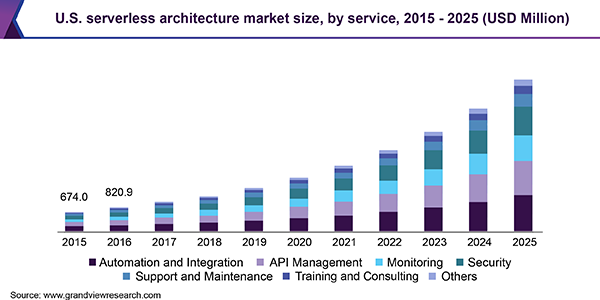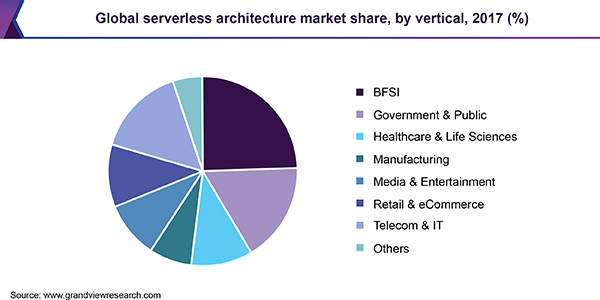- Home
- »
- Next Generation Technologies
- »
-
Serverless Architecture Market Size Report, 2018-2025GVR Report cover
![Serverless Architecture Market Size, Share & Trends Report]()
Serverless Architecture Market Size, Share & Trends Analysis Report By Organization (SME, Large Enterprises), By Vertical, By Service (Automation & Integration), And Segment Forecasts 2018 - 2025
- Report ID: GVR-2-68038-578-6
- Number of Report Pages: 141
- Format: PDF, Horizon Databook
- Historical Range: 2015 - 2016
- Forecast Period: 2018 - 2025
- Industry: Technology
Industry Insights
The global serverless architecture market size was valued at USD 3.14 billion in 2017. It is anticipated to register a CAGR of 26.0% over the forecast period. Rising awareness regarding benefits of serverless architecture such as increased process agility and reduced operational cost is one of the primary growth stimulants for the market. Moreover, from a developer perspective, benefits such as faster set up, easier operational management, and zero system administration are boosting their applications. Furthermore, emergence of cloud-based technologies along with third-party vendors to manage server component is likely to stoke the growth of the market.
With the adoption of serverless architecture, organizations can effectively eliminate expensive traditional and time-consuming approaches such as purchasing new hardware component, installing, configuring, and troubleshooting. It shifts the responsibility of managing servers, databases, and application logic, which reduces set-up and maintenance costs. Advancements in computing technology are enabling organizations to incorporate serverless environment, thereby augmenting the market.

Market dynamics are continuously changing owing to proliferation of artificial intelligence, machine learning, and IoT, among others. In this rapid technological shift, companies are under increasing pressure to release new products and features as well as reduce time-to-market to meet the exponentially growing consumer expectations. Increasing prominence of such trends is projected to work in favor of the market.
Serverless architecture has emerged as a revolutionary step in leveraging cloud-based technologies to their full potential. It is enabling enterprises to focus on their core products and services, instead of managing a load of traffic on their IT infrastructure. Thus, a user can run an application on a third-party server and reduce deployment time.
Over the past few years, there have been significant innovations in the enterprise IT space, which has enabled business agility, improved resiliency, and driven cost-effectiveness. In such landscape, serverless computing has emerged as a vital element for deployment of cloud services and applications. For instance, use of traditional cloud Infrastructure-as-a-Service model to develop a functionality that returns credit score check for mobile users as a part of mobile banking application could take up days or weeks for developing, testing, and delivering the functionality. However, with serverless computing such as AWS Lambda, same functionality can be developed in a few hours.
Services Insights
The automation and integration services segment dominated the market in 2017 with a revenue share of 26.5%. These services play a pivotal role in establishing a robust serverless architecture in any organization. Automation services allow third-party vendors to efficiently manage microservices, which are deployed on hybrid IT platforms to gain steady response time as well as optimum resource utilization. Similarly, integration services collate data and functions of multiple microservices to deploy robust serverless computing platforms.
The monitoring services segment is anticipated to witness the highest CAGR of 28.8% over the forecast period. In these services, vendors manage the underlying servers and their maintenance, allowing users to focus on the application code. In conventional client-server apps, users monitor the performance of in-house servers and network latency, among other functions. With a serverless platform, these metrics are eliminated, thereby increasing the scalability of the app.
Organization Insights
The small and medium enterprises (SME) segment is anticipated to exhibit the highest CAGR of 28.6% in the serverless architecture market. Serverless architecture offers significant advantages to SMEs; it offers flexibility and reduces overall infrastructure cost. Moreover, in a competitive market, startups are anticipated to scale rapidly and deliver enhanced features for their products and services, thereby improving their business values. Thus, to achieve minimum lead time and positively impact their business, an increasing number of startups are anticipated to adopt serverless technology, thereby propelling segment growth.
Vertical Insights
The banking, financial services, and insurance (BFSI) segment dominated the market in 2017 and is anticipated to retain its lead over the forecast period. As most companies in the BFSI vertical have a substantial user base, deployment of serverless architecture has enabled enterprises in auto-scaling to an unpredictable or highly variable demand and has facilitated in handling a variety of functions.

This helps optimize bank workflow, provides quick responses, and increases customer satisfaction. As banks focus on improving customer services with the help of innovative technologies, serverless architecture has reduced developers’ operational burden and enhanced productivity and performance.
Regional Insights
North America dominated the global market with a revenue share of 42.09% in 2017. The presence of prominent players in the U.S. has strengthened the regional market, with industries such as BFSI, manufacturing, healthcare, and retail boasting of a large user base. Thus, to remain competitive in the dynamic market and deliver new features and products quickly, enterprises are constantly innovating and adopting new technologies. This has allowed the North America market to grow at a rapid pace.
Asia Pacific is anticipated to present significant opportunities and exhibit the highest CAGR of 29.7% over the forecast period. Traditional IT infrastructure within industries such as manufacturing, retail, and BFSI are increasingly shifting toward automation. With implementation of new cloud-based technologies, serverless architecture is poised to witness significant growth over the forecast period. Besides this, increasing investments in digital transformation to reduce operation costs is anticipated to be a potential factor driving the APAC market.
Serverless Architecture Market Share Insights
The market is highly competitive and was dominated by Amazon Web Services Inc. in 2017. Various businesses are moving toward cloud services, adding to the existing competition. However, security still remains a major concern among adopters and cloud service providers are continuously working with cybersecurity vendors to negate these concerns and reduce any risk of cyber-attacks.
Major participants in the market include Amazon Web Services, Inc.; Alibaba Cloud; CA Technologies; Dynatrace; Fiorano Software, Inc.; Galactic Fog IP, Inc.; Google LLC; IBM Corporation; Joyent Inc.; Microsoft Corporation; ModuBiz Ltd.; Manjrasoft Pty Ltd.; NTT Data; Oracle Corporation; Platform9 Systems, Inc.; Realm; Rackspace Inc.; StdLib; Snyk Ltd.; SixSq; TIBCO Software Inc.; Tarams Technologies; and Twistlock.
Report Scope
Attribute
Details
Base year for estimation
2017
Actual estimates/Historical data
2015 - 2016
Forecast period
2018 - 2025
Representation
Revenue in USD Million & CAGR from 2018 to 2025
Regional scope
North America, Europe, Asia Pacific, Latin America, and MEA
Country scope
U.S., Canada, U.K., France, China, India, Japan, Brazil, and Mexico
Report coverage
Revenue forecast, company ranking, competitive landscape, growth factors, and trends
15% free customization scope (equivalent to 5 analyst working days)
If you need specific information that is not currently within the scope of the report, we will provide it to you as a part of the customization
Segments Covered in the ReportThis report forecasts revenue growth at global, regional, and country levels and provides an analysis on the latest industry trends in each of the sub-segments from 2015 to 2025. For the purpose of this study, Grand View Research has segmented the global serverless architecture market report on the basis of service, organization, vertical, and region:
-
Service Outlook (Revenue, USD Million, 2015 - 2025)
-
Automation and Integration
-
API Management
-
Monitoring
-
Security
-
Support and Maintenance
-
Training and Consulting
-
Others
-
-
Organization Outlook (Revenue, USD Million, 2015 - 2025)
-
Large Enterprises
-
SME
-
-
Vertical Outlook (Revenue, USD Million, 2015 - 2025)
-
BFSI
-
Government & Public
-
Healthcare & Life Sciences
-
Manufacturing
-
Media & Entertainment
-
Retail & Ecommerce
-
Telecom & IT
-
Others
-
-
Regional Outlook (Revenue, USD Million, 2015 - 2025)
-
North America
-
The U.S.
-
Canada
-
-
Europe
-
The U.K.
-
France
-
-
Asia Pacific
-
China
-
India
-
Japan
-
-
Latin America
-
Brazil
-
Mexico
-
-
MEA
-
Share this report with your colleague or friend.
![gvr icn]()
NEED A CUSTOM REPORT?
We can customize every report - free of charge - including purchasing stand-alone sections or country-level reports, as well as offer affordable discounts for start-ups & universities. Contact us now
![Certified Icon]()
We are GDPR and CCPA compliant! Your transaction & personal information is safe and secure. For more details, please read our privacy policy.
We are committed towards customer satisfaction, and quality service.
"The quality of research they have done for us has been excellent."





